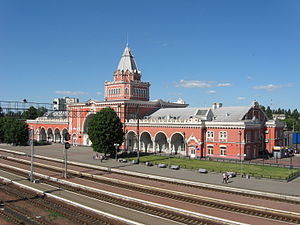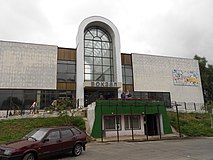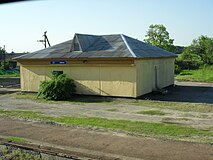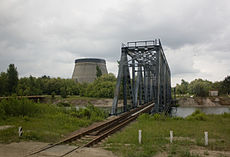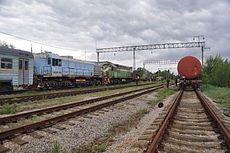
Chernobyl or Chornobyl is a partially abandoned city in the Chernobyl Exclusion Zone, situated in the Vyshhorod Raion of northern Kyiv Oblast, Ukraine. Chernobyl is about 90 kilometres (60 mi) north of Kyiv, and 160 kilometres (100 mi) southwest of the Belarusian city of Gomel. Before its evacuation, the city had about 14,000 residents. While living anywhere within the Chernobyl Exclusion Zone is technically illegal today, authorities tolerate those who choose to live within some of the less irradiated areas, and an estimated 150 people live in Chernobyl in 2020.

Kyiv Oblast, also called Kyivshchyna, is an oblast (province) in central and northern Ukraine. It surrounds, but does not include, the city of Kyiv, which is administered as a city with special status. However, Kyiv also serves as the administrative center of the oblast. The Kyiv metropolitan area extends out from Kyiv city into parts of the oblast, which is significantly dependent on the urban economy and transportation of Kyiv.

Pripyat, also known as Prypiat, is an abandoned industrial city in Kyiv Oblast, Ukraine, located near the border with Belarus. Named after the nearby river, Pripyat, it was founded on 4 February 1970 as the ninth atomgrad to serve the nearby Chernobyl Nuclear Power Plant, which is located north of the abandoned city of Chernobyl, after which the power plant is named. Pripyat was officially proclaimed a city in 1979 and had grown to a population of 49,360 by the time it was evacuated on the afternoon of 27 April 1986, one day after the Chernobyl disaster.

The Chernobyl Nuclear Power Plant Zone of Alienation, also called the 30-Kilometre Zone or simply The Zone, was established shortly after the 1986 Chernobyl disaster in the Ukrainian SSR of the Soviet Union.

Slavutych is a city and municipality in northern Ukraine, purpose-built for the evacuated personnel of the Chernobyl Nuclear Power Plant after the 1986 disaster that occurred near the city of Pripyat. Geographically located within Chernihiv Raion, Chernihiv Oblast, Slavutych is administratively subordinated to the Kyiv Oblast and is part of Vyshhorod Raion. It is coterminous with Slavutych urban hromada, one of the hromadas of Ukraine. In 2021 the city had a population of 24,464.
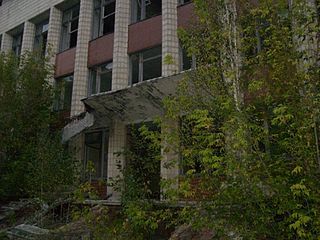
Poliske or Polesskoye is an abandoned settlement and former urban-type settlement in the Chernobyl Exclusion Zone, part of Kyiv Oblast, Ukraine. It is located on the Uzh River and was an administrative center of Poliske Raion (district). However, later the town was taken out of a registry as it was completely depopulated being located in the Zone of alienation. Currently around 20 people live there, so called samosely ("self-settlers").

Southwestern Railways (PZZ), headquartered in Kyiv, the capital of Ukraine, is a component part of the Ukrzaliznytsia company, its regional branch.

Kopachi was a village near Chernobyl, Ukraine, just south-west of the Pripyat River Basin. After the Chernobyl disaster in 1986 the village was contaminated by fallout and subsequently evacuated and is now within the Chernobyl Exclusion Zone; and thus has been abandoned since 1986.
State highways in Ukraine are subdivided into four categories: international (M-network), national (H-network), regional (P-network), and territorial (Т-network). The letter's indexes are in Cyrillic, standing for their respective abbreviations in Ukrainian.

The Belarusian-Ukrainian border is the state border between Belarus and Ukraine with a length of about 1,084 km (674 mi). It starts from the triple junction with Poland to the west and stretches to the triple junction with Russia to the east. The tripoint border at the triple border junction of Belarus, Russia and Ukraine is marked in the form of a monument, while at the other border junction there is a river, the Western Bug that coincides with the border of Poland.

The Polesie State Radioecological Reserve is a radioecological nature reserve in the Polesie region of Belarus, which was created to enclose the territory of Belarus most affected by radioactive fallout from the Chernobyl disaster. The reserve adjoins the Chernobyl Exclusion Zone in Ukraine. The environmental monitoring and countermeasure agency, Bellesrad, oversees the agriculture and forestry in the area.
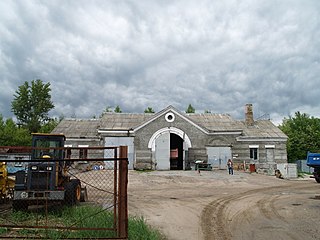
Yaniv is an abandoned village in Vyshhorod Raion, Kyiv Oblast, northern Ukraine. It is located south of Pripyat and west of the Chernobyl Nuclear Power Plant.
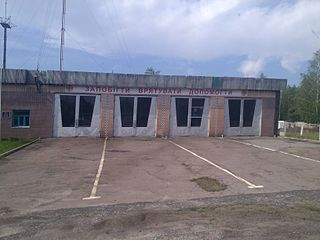
Vilcha is an abandoned settlement and former urban-type settlement in the Chernobyl Exclusion Zone, part of Vyshhorod Raion, Kyiv Oblast, Ukraine.

Stroitel Football Club Pripyat, also known as Budivelnyk Football Club Pripyat was a Soviet and Ukrainian football club (team) from Pripyat, Kyiv Oblast. Founded in the 1970s, it competed only at republican level competitions in Ukraine. Before the Chernobyl disaster the team was playing at a small stadium in Pripyat. In 1986, a new home ground, the Avanhard Stadium was built but never used due to the disaster.
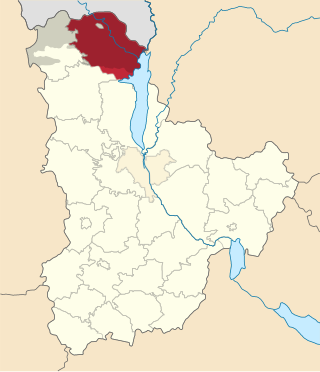
Chernobyl Raion or Chornobyl Raion was a raion in the Soviet Union located in the Ukrainian Soviet Socialist Republic. It was one of 26 administrative raions (districts) of Kyiv Oblast in northern Ukraine. After the Chernobyl disaster, the majority of the raion was contaminated, and many of its populated places were included into the Chernobyl Exclusion Zone, which is an officially designated exclusion area around the site of the disaster.

Yaniv railway station, also named Yanov station, is an abandoned Ukrainian station located in the Chernobyl Exclusion Zone. Sometimes referred to as Pripyat station, it lies in the village of Yaniv, south of the city of Pripyat, and is part of the Chernihiv–Ovruch railway. It is included in the transport sector state-owned enterprise Chernobylservis.

Vilcha railway station, previously Oleksiivka, is a station in Vilcha, Kyiv Oblast, not too far from Pripyat. It is part of the Chernihiv–Ovruch railway, and is included in the transport sector state-owned enterprise Chernobylservis. As of 2022, it is officially active, but there is no passenger service.

During the Russian invasion of Ukraine, the Chernobyl Exclusion Zone was captured on 24 February, the first day of the invasion, by the Russian Armed Forces, who entered Ukrainian territory from neighbouring Belarus and seized the entire area of the Chernobyl Nuclear Power Plant by the end of that day. On 7 March, it was reported that around 300 people were trapped and had been unable to leave the power plant since its capture. On 31 March, it was reported that most of the Russian troops occupying the area had withdrawn, as the Russian military abandoned the Kyiv offensive to focus on operations in Eastern Ukraine.

The 1st Nuclear Power Plant Defense Battalion is a battalion of the National Guard of Ukraine tasked with CBRN defense especially in the Chernobyl Exclusion Zone in the aftermath of the Chernobyl Disaster and has therefore seen combat against Russian forces during the Capture of Chernobyl amidst the Russian invasion of Ukraine with 169 soldiers of the Battalion being taken captive. In its current form, it was established in 1991 and headquartered at Slavutych.
